INVESTIGATIONS
Violence in Khartoum and Omdurman at December 30, 2021 anti-coup protests
December 30, 2021Documentation of violence against civilians, resulting in at least five deaths and scores injured
Print Article
Introduction
This report is a continuation of the Coup Files series of investigations, in which the Sudanese Archive takes an in-depth look at violent events on key days in Sudan since a military coup took place on October 25, 2021. This investigation focuses on December 30, 2021, a day in which thousands of protesters marched across the country to oppose the coup. It follows up on a video already produced and posted to Twitter about violence against protesters that occurred on that day. The United States Embassy in Khartoum issued a statement on Twitter condemning the violence that occurred on December 30, and United Nations Special Representative for Sudan Volker Perthes called for "credible investigations into these violations."
This is not meant to be a comprehensive recap of everything that happened on December 30, 2021. There were reports of many violent events that took place that day, and it is beyond the scope of this article to detail each one. Instead, the Sudanese Archive is publishing this article in an attempt to verify specific events, primarily in Khartoum and Omdurman, that occurred that day and were documented in open source media. This report aims to contribute to a historical record of these protests and subsequent violence, as well as to accountability processes, including through advocacy, court systems and transitional justice mechanisms.
Various types of violent events were reported to have occurred, including the violent detention and arrest of numerous protesters, and reports of excessive crowd control methods, such as the use of teargas and other weapons fired directly toward demonstrators resulting in injuries and five deaths. As well, according to a report by Insecurity Insight, security forces attacked or obstructed healthcare in several ways including: arrests or attempted arrests of injured civilians in hospitals (including in an intensive care unit) and in at least one ambulance; use of teargas inside multiple hospitals; and the attempted seizure of corpses that were inside a hospital.
The Sudanese Archive archived documentation of protest violence in various locations around the country. However, this article focuses specifically on one geographical area of the country: the twin cities of Khartoum and Omdurman. Below, we detail as much as we could verify as to what happened, where and when.
The visual evidence
The Sudanese Archive has previously investigated violence against civilians by security forces during protests following the October 2021 coup, specifically on Oct 30, 2021 and Jan. 17, 2022. Our research identified civilians being injured and killed while engaging in peaceful protests, and identified the coordination of mixed security forces, including what appear to be the police and riot police, and the Sudanese military. On Dec. 30, 2021, reports from media and advocacy organizations identified similar patterns of violence, including the use of gunfire, teargas and water cannons against peaceful protesters, resulting in injuries and several deaths. Multiple beatings and arrests
The Sudanese Archive collected content that documents multiple arrests of civilians in Khartoum and Omdurman on Dec. 30. While it was often not possible to determine the events that led up to the arrests due to the short length of the videos showing the arrests taking place, we were able to confirm that authorities used force to apprehend civilians; additionally, we identified indicators of excessive force. One incident shows security forces beating a man while pushing him toward a police truck. In another, security forces beat a man already laying on the ground. A third incident documents security forces beating a man laying on his stomach and not appearing to be resisting arrest. In all three cases, those perpetrating the violence are wearing blue and tan camouflage uniforms, and in two cases people in civilian clothing are also part of those beating the civilians.
In this video posted to Facebook on January 3, 2022, security forces can be seen beating a man in an attempt to get him to climb into a police truck, apparently to arrest him. The security forces are wearing dark blue camouflage pattern uniforms, and some wear helmets and black vests labeled police. These uniforms are typically affiliated with the Riot police, and those uniforms can be compared to those on the police’s official social media accounts. The vehicles are also blue camouflage. At least one man is seen wearing civilian clothing, and a white head scarf covering his face. This man can be seen in the video beating the man with what appears to be a large stick or cane. We were unable to verify that this event took place on December 30, although the Facebook user who posted the video used a hashtag associated with the violence that occurred on December 30, 2021; additionally, the shadows cast on the ground are consistent with what the shadows would have looked like in late afternoon on December 30, 2021 in Omdurman. We were able to verify the geolocation of this incident to 15.641157, 32.480245, as shown in the annotated images below.
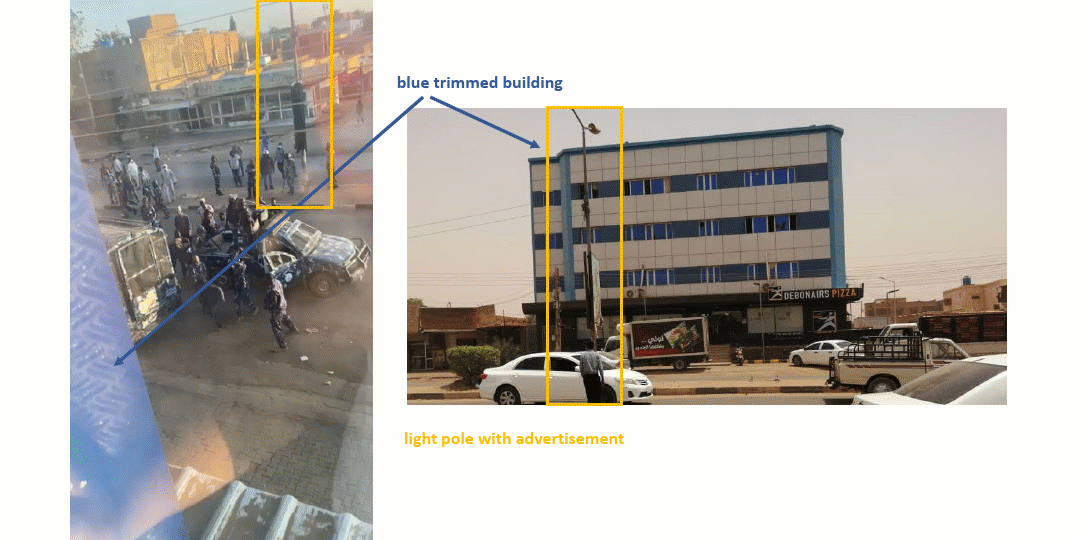
We also documented multiple beatings of civilians by authorities in a sustained manner; in other words, once the civilian was subdued, the beating continued. In this incident for example, documented in a video posted to Facebook on December 30, authorities wearing both blue and tan camouflage pattern uniforms continually beat a civilian after he is on the ground. Again, these are likely to be Riot police and Central Armed Forces, based on our tagging methodology which identifies perpetrator characteristics, such as uniforms. This incident allegedly took place in Khartoum on December 30. A man with a white scarf on his head was also involved in the incident with the civilian.
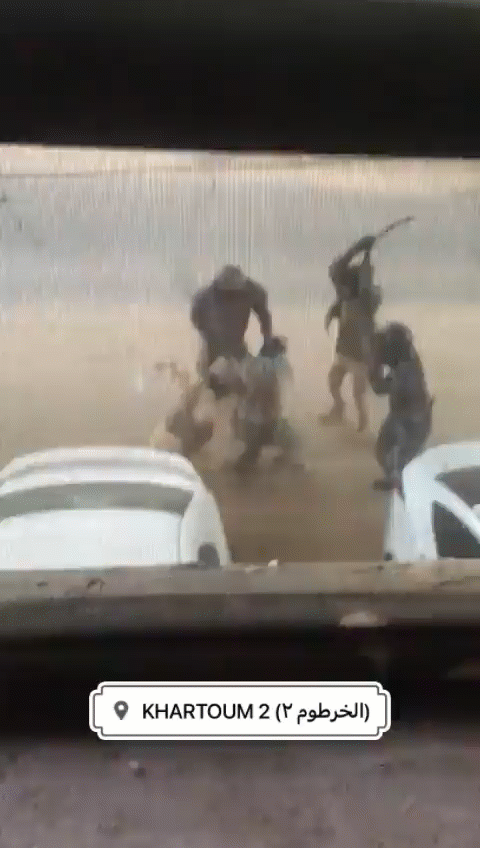
Another example of an apparently excessive beating can be seen in this incident, shown in a video posted to Facebook on December 30. Men wearing both blue and tan camouflage pattern uniforms, as well as men wearing civilian clothes, beat a man who is lying in the prone position, flat on his chest, with his back facing up, on the ground and not appearing to be resisting arrest. He is beaten with large sticks and kicked.
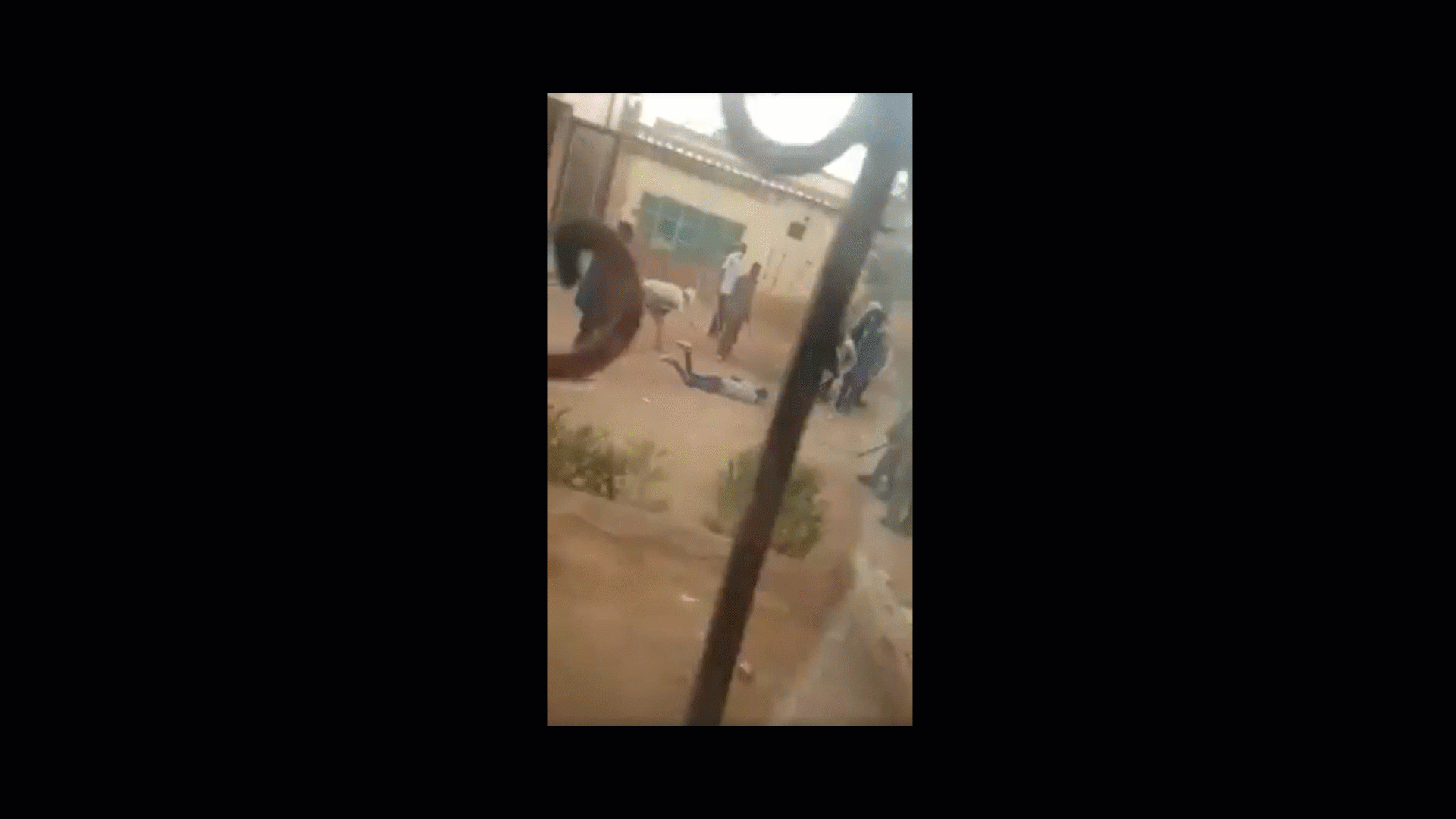
Shootings near Alia Hospital in Omdurman
The Sudanese Archive also analyzed documentation of several shootings of civilians that resulted in either injury or death. Since the total number of instances in which authorities fired upon civilians in Khartoum and Omdurman is unclear, we will focus on one area of Omdurman in which a high concentration of such events occurred. We will focus on the area around Alia Specialist Hospital, located in Omdurman, as shown in the graphic below.
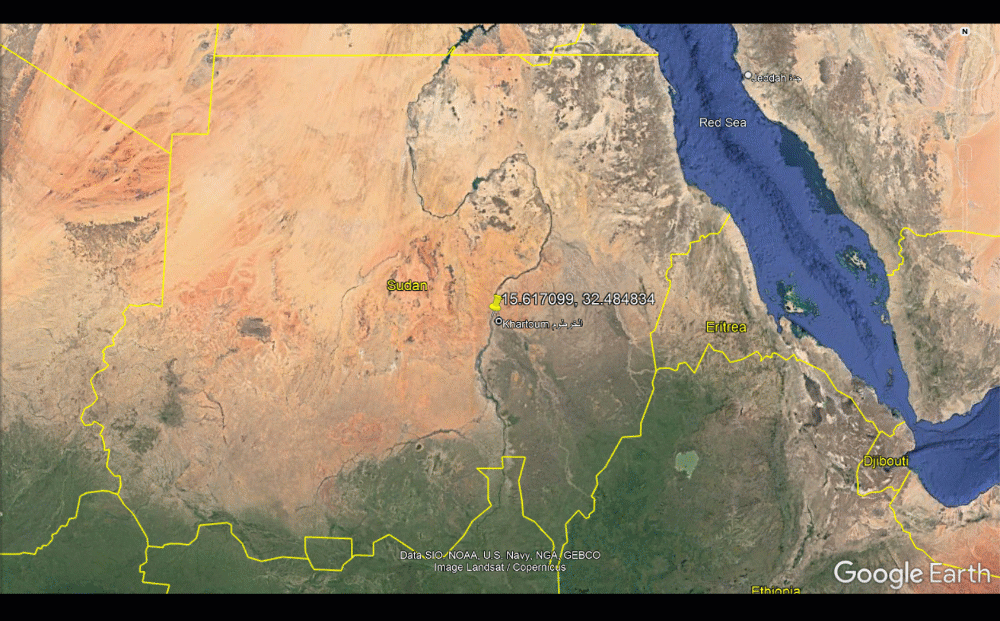
According to our analysis of open-source content, at least two civilians were shot in the area near Alia Hospital. We documented one instance in which a protester was shot when he was near the apparent front edge of the protest. In this video posted to Twitter at about 10 seconds in, we see the individual beginning to run away from the direction of where the authorities were firing. We see the individual fall to the ground. He is eventually carried off by other civilians. The video below describes what transpired during this incident frame-by-frame. We have modified the original video by stabilizing the motion of the camera using a forensic video analysis tool and by adding annotations, such as the current frame number displayed and narrative text describing what is happening in the scene.
We found a (graphic) picture posted to Facebook of the deceased with an apparent gunshot wound, which appeared to be an entrance wound according to a medical expert that the Sudanese Archive consulted with, located on his chest which appears to match the anatomical location of the wound seen in the video from the protest. The Gucci shirt of the deceased matches the shirt of the protester seen in the video.
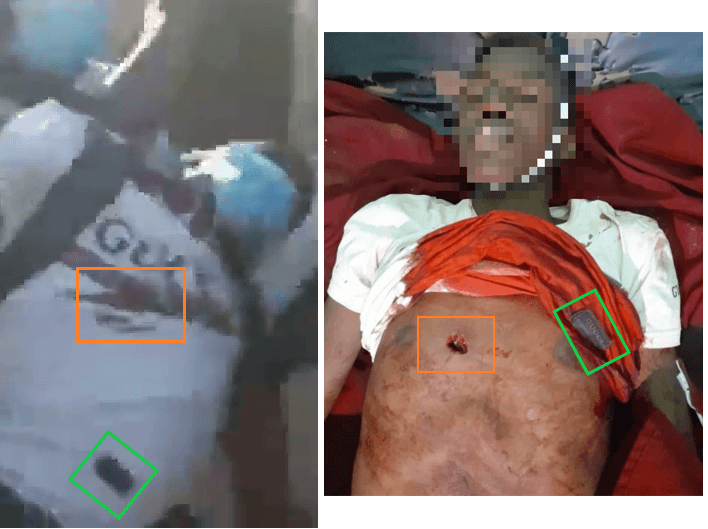
In addition to the incident we detailed above, the Sudanese Archive also found information indicating at least one other shooting in the area of Alia Specialist Hospital in Omdurman. We found this Facebook video that appears to show a civilian wearing a yellow shirt being shot from long range. He appears to be shot in at least one of his lower extremities, possibly his left leg. We were unable to positively identify this individual. However, we did find another Facebook video that shows an individual who is wearing a yellow shirt lying in what appears to be a hospital gurney with his left leg bandaged. It is unclear from the videos if these two individuals are the same person, but it appears that they were wearing similar clothing and were allegedly shot in the same area. The Sudanese Archive was unable to confirm whether these videos are from the same incident or separate incidents.
News station attack
We also documented an attack in Khartoum on Al-Arabiya/Al-Hadath news station in which security forces physically beat and harassed journalists in their newsroom. This video posted to Facebook shows authorities entering an office, beating individuals with sticks or batons, and releasing teargas. The timestamp on the digital video recorder that recorded the CCTV footage was likely incorrect. As such, to verify what happened and when, the Sudanese Archive spoke with the director of the news station, who described not only physical beatings but also verbal harassment and theft. The director said that around 10 members of the police were involved — specifically, the Central Reserve and Riot Control police. The police also stole a small amount of money from one employee’s pocket, as well as at least four mobile phones, according to the director, who confirmed that the attack occurred between 5:15 p.m. and 5:45 p.m. on December 30.
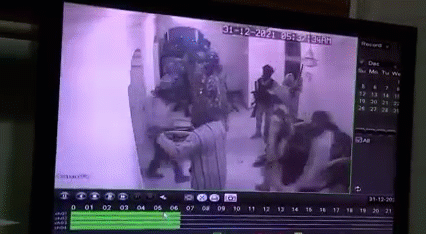
The United Nations Office of the High Commissioner for Human Rights (OHCHR) released a statement on January 18, 2022 condemning the December 30 attack.
Rickshaw incident
Another incident involved civilians traveling in a three-wheeled taxi, commonly called a raksha in Sudan, on December 30. It is unclear the exact nature of the incident, however the person filming can be heard saying they are thieves and stole her bag. Again, it appears to be the same perpetrators as seen in other incidents on the same day, including those in blue and tan camouflage uniforms. The Sudanese Archive resized and cropped the video, as well as added an optical deblurring tool, to produce this video which shows a closer view of the perpetrators of this apparent misconduct incident. We also produced the following screenshots showing the varied uniforms of the perpetrators: here, here, and here.
Victims
There were reports of many violent events that took place on Dec. 30, 2021, including numerous reports of injuries and civilian deaths. This investigation identified several incidents in which protestors appear to have been directly injured or killed. These include:
- Three incidents of beatings of civilians using sticks or batons, detailed in this report
- Other videos of beatings that were archived
- One incident of shooting toward civilians from a moving vehicle
- One video and photo documenting the deadly shooting of a protester
Reports indicate that at least five people were killed and approximately 200 people were injured during protest violence in the Khartoum-Omdurman area on December 30. The Central Committee of Sudanese Doctors (CCSD) initially said that at least four people had been killed; however, the group posted a Facebook update on January 1, 2022, saying that a total of five people had been killed on December 30, including one minor who was shot in the chest. The group also alleged that authorities opened fire on protesters in Omdurman.
In order to verify these and other claims, the Sudanese Archive used open-source intelligence methods to collect, preserve, and analyze online content, including photos, videos, and text. Several videos, such as this one posted to Twitter, showed injured civilians being carried off by other civilians, presumably after having been injured by authorities’ use of force. As well, this video posted to Facebook shows four dead bodies at Mustashfa Arbaeen (Forty Hospital) in Omdurman. The bodies are covered, so were we unable to verify the identities of the individuals; however, the CCSD named at least five deceased individuals with their names, ages, and injuries in the aforementioned Facebook post. It is unclear if the four bodies seen in the Facebook video match the names listed in the CCSD Facebook post.
Additionally, this (graphic) Facebook post contained six photos of injuries on dead bodies. Two of the photos posted were of the same deceased individual with a large, and apparently fatal, head wound. In a (graphic) video posted to Facebook, a deceased male individual was being carried off by multiple people. From the video, it appears the man has a large head wound to the back left of his head with large amounts of blood dripping off, and a large indentation can be seen on his left forehead. Seconds later in the video, we see what is apparently his brain being carried by another individual. Two of the photos posted to Facebook appear to be of the same deceased individual with a matching injury. It remains unclear how exactly the man was killed.
This documentation of violence toward civilians is corroborated by reports from the media and a medical organization. Dabanga, an independent Sudanese news organization, reported that “four protesters were shot dead by security forces in Omdurman (on December 30),” and an additional individual died the following day due to injuries sustained “after being hit by a tear gas canister in the chest.” As well, the Central Committee of Sudanese Doctors (CCSD), as referenced above, documented the deaths of at least five individuals. While the Sudanese Archive was unable to independently confirm the precise circumstances surrounding each of the deaths, we were able to collect information culled from online open sources about the victims.
The Sudanese Archive verified several media files that document an apparent shooting of a protester resulting in his death. Based on verified documentation, social media posts, and public statements, it is likely that this man is Mutawakkil Youssef Saleh (متوكل يوسف صالح). In the video of the incident, as described above, a man can be seen dropping to the ground, and is wearing a T-shirt bearing the name Gucci. That same shirt is seen on another photo documenting an injured man who appears to have been killed. The investigative team found numerous social media posts sharing the same image of a man in this same clothing - one of the body laying on the table - that identify him as Saleh. As well, a Facebook post shows a man wearing that shirt and identifies him by the same name. Many of these posts come from people with the same Saleh or Salih name, likely to be family members. We have chosen not to link directly to those posts to protect the identity of those people. The same name, Mutawakkil Youssef Saleh, was also identified in a statement by the CCSD released on Jan. 1 as having died on December 30 due to at least one gunshot to the chest. The CCSD identifies him as 17 years old.
Another victim that day, Muhammad al-Mustafa Majid Muhammad Ali (محمد المصطفى ماجد محمد علي), who we believe goes by the nickname “Bebo,” died due to injuries sustained on December 30, and was likely killed due to at least one gunshot to the head. Based on information from CCSD, we believe he was approximately 18 years old at the time of his death. This photo posted to Twitter, as well as this one posted to Facebook, appear to be of Muhammad al-Mustafa Majid Muhammad Ali. This YouTube video also claims to depict Muhammad al-Mustafa Majid Muhammad Ali prior to his death. There are numerous other Tweets that mourn the death of Muhammad al-Mustafa Majid Muhammad Ali; the following are some examples of what we found: here, here, here, and here (graphic).
Mustafa Muhammad Musa (مصطفى محمد موسى) was reported to have died due to injuries sustained on December 30, and was likely killed due to at least one gunshot to the chest. According to the CCSD, he was approximately 28 years old at the time of his death. This photo posted to Twitter appears to be of Mustafa Muhammad Musa. Numerous other Tweets mourning the death of Mustafa Muhammad Musa are here, here, here, and here.
Ahmed Al-Amin Kanuna (أحمد الأمين كنونة) also is reported to have died due to injuries sustained on December 30, and was likely killed due to at least one gunshot to the head. According to the CCSD, he was approximately 28 years old at the time of his death. We identified this (graphic) Facebook post that contained six photos of injuries on dead bodies. Two of the photos posted were of the same deceased individual with a large, and apparently fatal, head wound; we believe this individual is Ahmed Al-Amin Kanuna. In a (graphic) video posted to Facebook, as described above, a deceased male individual is being carried off by multiple people. From the video, it appears the man has a large head wound to the back left of his head. Two of the photos posted to Facebook appear to be of the same deceased individual with the matching injury, and we found this photo posted to Twitter who the poster claimed was of Ahmed Al-Amin Kanuna, and that he died due to a gunshot to the head.
As well, Bassam Hassan Juma (بسام حسن جمعة) is reported to have died due to injuries sustained on December 30, and was likely killed due to a blunt force trauma to the chest, possibly from a tear gas canister. Based on information from CCSD, we believe he was approximately 21 years old at the time of his death. We found this Facebook post, as well as this Facebook post, that claimed that he died the following day, December 31, while this Facebook post claimed that he died on January 1, 2022. We also found several photos on Twitter that appear to be the same photo from the Facebook posts mentioned above. The pictures appear to be Bassam Hassan Juma lying in a hospital bed and can be seen on Twitter here, here, here, here, here, here, here, and here.
Potential perpetrators
Each of the incidents identified in this report show the presence of uniformed people that are likely to be the Central Reserve Forces and the Riot Police, as well as several individuals in civilian clothing participating in the incident or holding weapons. It appears these groups are working together, indicated through their interactions and shared role in perpetrating violence in videos analyzed for this investigation. These perpetrators were determined using our methodology and tagging system, which identifies any visible uniforms, vehicles and weapons and then draws conclusions based on that documented information. The Sudanese Archive team then corroborates our conclusions with external sources, such as media reports, testimony, and human rights agencies.
The perpetrators also appear to be equipped with and use large caliber guns, such as can be seen in this video posted to Twitter in which an apparent anti-aircraft gun mounted in the bed of a pickup truck is fired into the air. Unidentified gunfire could also be heard in the background as protesters were retreating, such as in this video posted to Facebook. Large amounts of automatic gunfire could be heard in this video posted to Facebook but since deleted. And in a Twitter video modified by the Sudanese Archive to stabilize the motion of the camera, we can see and hear security forces shooting large caliber weapons into the air in an apparent effort to intimidate or disperse protesters. (Click here to see the original video posted to Twitter, and click here to see the modified video.) The visual demonstrative below shows a portion of the video in which authorities can be seen firing large caliber weapons into the air.
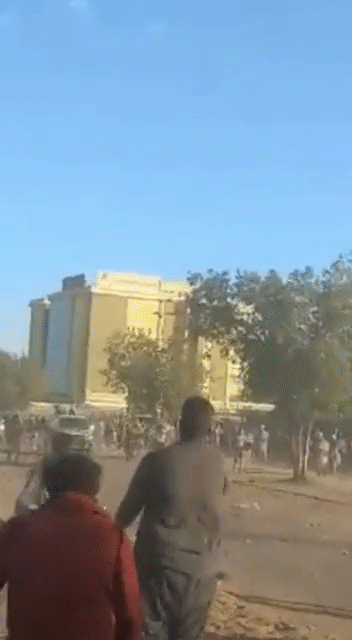
Use of force under international law
The use of force, including the use of less-lethal weapons such as teargas for the purposes of crowd control, is legitimate only when necessary and proportionate. Indiscriminate use of teargas and other less-lethal crowd control methods can constitute excessive use of force. In line with international standards, teargas should only be employed when necessary to prevent imminent physical harm and should not be used as a first resort to disperse nonviolent demonstrations. Security forces and law enforcement should also issue audible, adequate warnings before using teargas, and should avoid exacerbating the situation. Additionally, security forces should avoid targeting enclosed spaces with teargas, including spaces where protestors are trapped behind barricades.
The use of live ammunition and/or lethal force when there is no imminent threat to life or imminent risk of serious injury violates international human rights standards. Intentional lethal use of firearms may be made only “when strictly unavoidable in order to protect life,” and firearms should never be used simply to disperse a peaceful assembly. Security forces must make every effort to minimize damage and injury at all times by using only the minimum level of force necessary, including by refraining from the indiscriminate use of live fire and intentional targeting of protestors’ heads and chests. Sporadic violence by some protestors that is not an immediate threat to life, such as stone throwing or kicking of teargas canisters back at security forces, does not justify the use of lethal force by security forces and law enforcement.
Limitations
We acknowledge the limitations of this investigation, in that it is not comprehensive and does not provide a full scope of what happened on December 30, 2021 in Sudan, or even in Khartoum and Omdurman. There is a plethora of online evidence available that remains to be verified in order to give a fuller, more detailed and accurate account of what happened. To conduct such a broad scope investigation is not the intent of this article or of the Coup Files project. Instead, this investigation seeks to highlight specific, verifiable content in order to ascertain what happened, with reasonable certainty. Our methodology includes a replicable workflow that abides by the guidelines set out in the Berkeley Protocol on Digital Open Source Investigations.
Note on Methodology
The Sudanese Archive documented multiple instances of authorities beating civilians in a sustained manner, arresting them, or using weapons. We were able to verify that multiple such instances took place on December 30 through phone interviews, news reports, on-the-ground reporting, and some user-generated content that was collected remotely; however, while we have strong confidence that the incidents in this report took place in or around Khartoum or Omdurman, we do not have the same level of certainty regarding the timeframe of when the respective video might have been shot. Due to metadata stripping that many social media companies conduct when processing videos for upload to their platforms, we were unable to confirm with complete certainty the accurate date and time of some of the videos described below. If we were able to verify the exact time, it was noted in the text. Oftentimes, social media users upload videos several hours, or even several days or weeks, after an incident occurred due to electricity or internet blackouts or fear of reprisal, so the fact that a video was posted hours, days, or weeks after an incident occurred is not indicative of when it was shot. We use chronolocation techniques, such as shadow analysis when shadows are visible in the video, to estimate the time at which a video was shot; however, without original video files that contain intact, unaltered metadata, it is difficult to ascertain with any certainty the recording date of a video posted to many social media platforms.
Conclusion
Having analyzed visual documentation posted to social media platforms, the Sudanese Archive concludes that it is highly probable that Sudanese security forces - specifically the riot police and Central Armed Forces - use of force caused the deaths of civilians. In this report we identified several violent incidents in which security forces wearing blue and tan camouflage uniforms, and some in civilian clothing, coordinated their actions to use violence toward peaceful and non-resisting protesters, including through beatings and arrests. We also corroborated these incidents with media articles, reports from medical groups, and other documentation of the day. These patterns of violence and perpetrators identified appear to match those in other violence occurring against anti-coup protesters on other days, including Oct. 30, 2021 and Jan. 17, 2022, and in incidents during anti-regime protests in 2019. This indicates a pattern of coordinated and organized behavior over several months and years orchestrated often by the same perpetrators.
Taken together, open source documentation indicates that those security forces attempted to control protesters in Khartoum and Omdurman through various and forceful means on December 30, 2021, including: intimidation, physical beatings, shootings, and arrests.